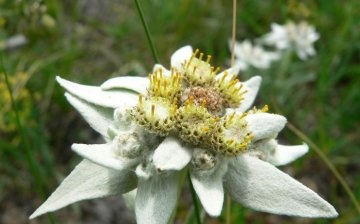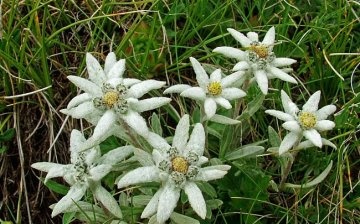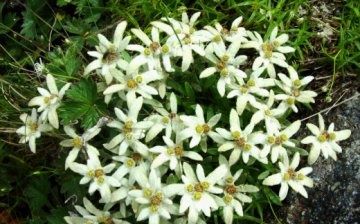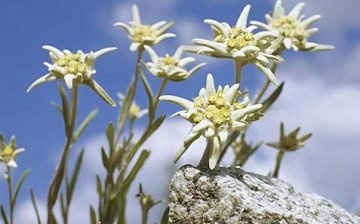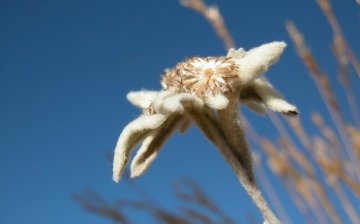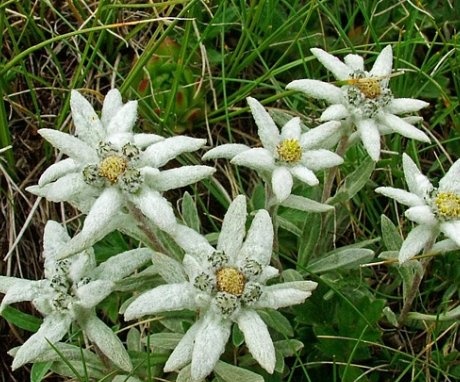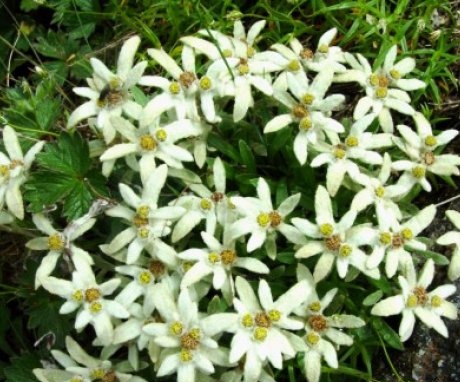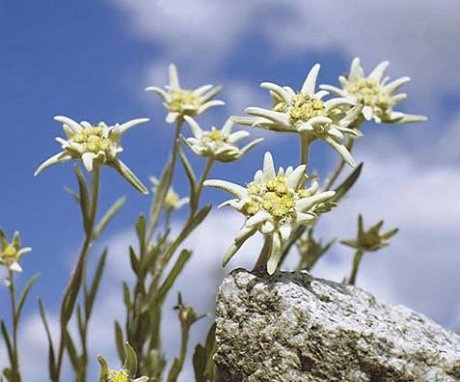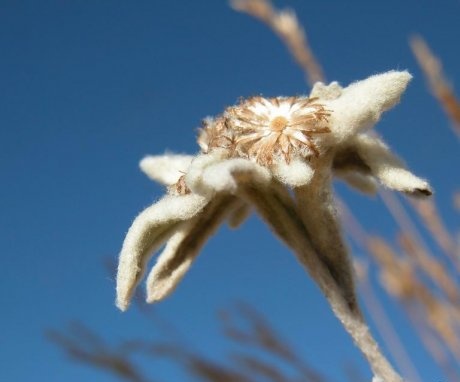Edelweiss: variety of species and features of growing at home
Edelweiss grows very slowly, in the wild it is most common in its homeland - in the countries of southern and central Europe. In Latin, edelweiss is translated as "lion's paw", with which it really has similarities.
Content:
Description of the plant
Edelweiss is an alpine flower, it belongs to the Asteraceae family, is herbaceous perennial plant.
Edelweiss is mentioned in many legends and tales, it looks truly magical, it is difficult to confuse its light beige flowers with another plant.
Flower features:
- White bracts reach 10 cm in diameter, which entwine yellow inflorescences.
- The flowers peek out from the gray-green leaves and are soft to the touch.
- Some flowers can grow up to 30 cm in height, on average, the height fluctuates within 15 cm.
- Each representative can grow to the sides for a distance of more than 20 cm, this is due to a creeping rhizome and self-seeding. That is why it is advisable to use edelweiss as a soil crop.
Select conditions for growing edelweiss follows on the basis of its natural growing conditions, that is, the climate should be cool. The best soil for a flower is considered to be sandy or stony.
Designers use edelweiss for rockeries that adorn alpine gardens.
They look great in borders, flowering continues until late autumn. In order for the flower to continue to delight the eyes of its owners, it can be dried for the winter and various compositions of bouquets can be created. When creating a rock garden, it is important to remember that edelweiss does not tolerate humid air. If severe frosts occur in winter, then the aerial part of the flower dies off, but already in the spring a new one appears from the underground rhizomes.
Variety of edelweiss species
In total, there are about 30 different types of edelweiss.
They are more common in the southeast of Asia. The flower does not grow in South America, Western Asia and the Caucasus. In the countries of the former USSR, 12 species of edelweiss grow, which are found in the Far East, Sakhalin and the Kuril Islands.
Among them are the following types:
- Alpine.
- Two-tone.
- Dwarf.
- Kurilskiy.
- Siberian.
- Himalayan.
- Bored.
- Steppe.
- Edelweiss-like.
And now in more detail about each species:
- Alpine edelweiss can be found in Asia Minor, Central Asia and Europe. It grows mainly on gravelly slopes, cornices and rocks, shale and limestone. The height of the bushes is up to 25 cm, the stems are curved. Abundant pubescence gives the plant a noble silvery color. The flowering period is short, only 3 weeks, starting in July.
- Edelweiss bicolor is distinguished by soft felt bracts. The flower is widespread in Sakhalin and Moneron, in Japan and Korea, it prefers sea and river banks, rocks and talus, rocky slopes.
- Edelweiss dwarf loves height, common in the Himals, Central Asia and China at an altitude of more than 3 thousand meters. The only species whose bracts do not grow in the shape of a star.
- Kuril edelweiss has a large bracts and grows in the Kuril Islands on the sea shores and mountain tops.
- Siberian edelweiss is similar to the alpine species. It can be found in Korea, Mongolia, Siberia in the mountains and steppes. Flowers are small, flowering period lasts from June to September.
- Himalayan edelweiss is widespread in the Himalayas and Tibet high in the mountains.
- Edelweiss pale yellow mainly lives in Mongolia, the Far East and Siberia. Its "star" has many rays, so it is rarely symmetrical and regular in shape.
- Edelweiss edelweiss has great decorative value. The bracts do not form a typical star, the inflorescence has from 2 to 5 baskets. It develops well in rocky areas, bouquets stand in water for a long time, and when dried, retain their color and shape.
Growing conditions
It is quite easy to grow and care for edelweiss. Depending on the type, it can be both annual and perennial representatives. The cultivation is carried out on dry, calcareous, light drained soils. The worst thing for edelweiss is stagnant water and high levels of air humidity.
In France, edelweiss is called the alpine star, as the inflorescences are surrounded by star-shaped leaves.
Growing edelweiss:
- Flowering begins at a variety of times, from June to August, and ends in mid-late autumn.
- Due to the mountainous origin, it is advisable to add coarse sand or crushed stone to the soil in order to bring the conditions as close as possible to natural ones.
- Nutrient soil is not only unnecessary for edelweiss, but it will also oppress the plant, it will grow at the same rate, but will lose its decorative properties, that is, the part with shoots will develop, and not flowers. Poor soils and places between stones will be beneficial.
- From fertilizer is only tolerated by humus, which is advisable to make in spring.
- The plant needs open sunny places, in color compositions it looks good with sunflowers, saxifrage, armeria, etc.
Edelweiss easily propagates by dividing the bush, periodically this operation is performed to rejuvenate the plant.
There is no need to be afraid to grow a plant in your garden, if climatic conditions and temperature conditions allow, because the fact that edelweiss grows only in the mountains is a long-refuted stereotype. The stem and leaves of edelweiss are covered with gray tomentose pubescence, which is necessary for the plant to prevent excessive evaporation of moisture.
Reproduction methods
Despite the fact that edelweiss is propagated in various ways, the most common is with the help of seeds.
It will be easier for amateur gardeners to buy ready-made seedlings and plant them already. Sowing is carried out from February to March. For edelweiss, a 1: 2 mixture of sand and deciduous soil is best suited.
- The seeds are not laid inside the soil, but are scattered over the surface in boxes. Then the container is covered with film or glass and removed only when the first shoots appear.
- Edelweiss grows very slowly, so do not worry if other plants have already risen, but the mountain representative has not yet.
- Already at the beginning of May, the seedlings are transferred to open soil. Reproduction can be carried out in the fall by dividing the bush.
- The only problem when dividing can be densely intertwined roots, which, when untangled, can break, which is highly undesirable to allow.
- The ambient temperature should be within 15 degrees, then the seedlings will begin to break out of the ground in 2-3 weeks.
- It is important to ensure that there is no waterlogging of the soil.
- Edelweiss is transplanted into a separate container when the flower reaches 2 centimeters.
- Edelweiss will begin to bloom next year, it should be transplanted to a new place at least once every three years, this is done to maintain decorative qualities.
Edelweiss is a low plant, therefore, when growing it with other crops, you also need to select low-growing varieties so as not to block the light.
Having grown edelweiss in his garden, a person can not only decorate your site thus, but also make a small contribution to the ecological situation, because the flower is included in the Red Book and needs to be protected and reproduced. Using the plant as a dried flower for winter compositions, you can not be afraid that it will lose its color and shape.
More information can be found in the video.



